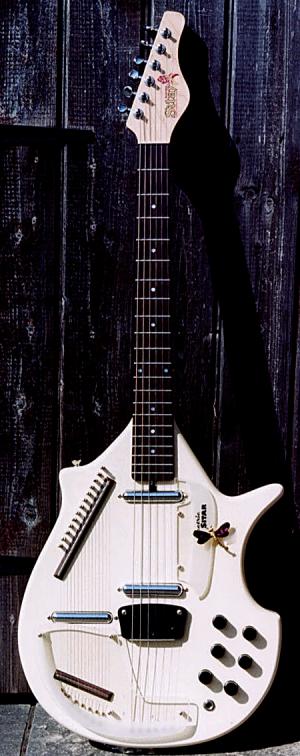
George Harrison's interest in Indian music, and the sitar in particular, began in 1965 during the making of The Beatles' movie "Help!", and soon influenced a generation of young musicians following his use of it on their albums Rubber Soul, Revolver and Sgt. Pepper's Lonely Hearts Club Band. Its sound became an integral part of the burgeoning psychedelic movement despite being very difficult to play, let alone amplify, so skilled performers like Jeff Beck, Jimmy Page and Tomorrow's Steve Howe made passable imitations of it on their electric guitars.
Meanwhile, in the U.S.A. session guitarist Vincent Bell had devised a novel "Buzz-bridge" that more accurately mimicked the unique sound of the sitar, and set about designing an instrument that any guitarist could use. The result was the oddly shaped Coral electric sitar, manufactured by the Danelectro company, which first appeared in the stores towards the end of 1967. It wasn't in production long - Danelectro ceased trading the following year - and its success was limited, though its impact became more widely felt during the 1970's, featuring on dozens of hits from the Tamla Motown stable and Philadelphia soul acts such as The Stylistics. Consequently, prices of second-hand examples began to spiral, eventually leading to the newly-formed Jerry Jones company of Nashville, Tennessee re-issuing the original Coral sitar design in the mid-1990's, and - dare I say it - making a few improvements into the bargain.
The characteristic buzzing effect is achieved as the strings vibrate over a carved rosewood "table" approx. 1½" long, which is very subtly curved in profile. This makes setting up the action and intonation an exact science, with the table mounted on three adjustable screws that must be set just so. Helpful instructions as to the procedure are supplied with your new sitar! To the left of the six main strings are a set of 13 sympathetic "drone" strings - all plain .010" gauge - which can be tuned to chords or scales of one's choice, starting in the range one octave above the open top E. A harp wrench is supplied for this tedious process. A clear perspex guard keeps the player's forearm off the drones when playing on the normal strings. Each of the sitar's three pickups has an individual volume and tone control, the pickups themselves being suitably skinny-sounding lipstick-tube repros.
The most notable improvement on Bell's original design is in the neck, made of a single piece of maple with a rosewood fingerboard, and attached to the acoustic sound chamber by four bolts. The head stock has been re-designed, with a more compatible overall shape, and equipped with individual sealed Gotoh tuners, the strings pulled perpendicularly across the nut. Bell's version dragged the strings slightly sideways into the stock, creating more tuning problems as the strings grabbed in the nut-slots.
All of the original Corals were supplied in a "Red Gator" finish, i.e. a crinkly red-and-black mock-alligator "skin"; the good people at Jerry Jones now offer this, plus alternatives of Black, Turquoise or Cream Gator (pictured). And for an extra $120, you now get a fabulous heavy-duty rectangular case with stitched vinyl ends, brown "Mock-Croc" covering and a thick, lurid radioactive red lining - too cool for words! When you consider the silly prices the originals are now attracting, you'd be foolish not to check out a Jerry Jones if this particular sound floats your boat (weirdo!).
And the dragonfly? I'd love to say it just flew into shot as I opened the shutter, but no; a hapless peddler called at the door the day the sitar was delivered, with a big tray of brooches and the like. I found one that I felt would look at home on my new acquisition, and it's been there ever since…
You can hear this sitar on the latest Dukes Of Stratosphear release - see news page for details!